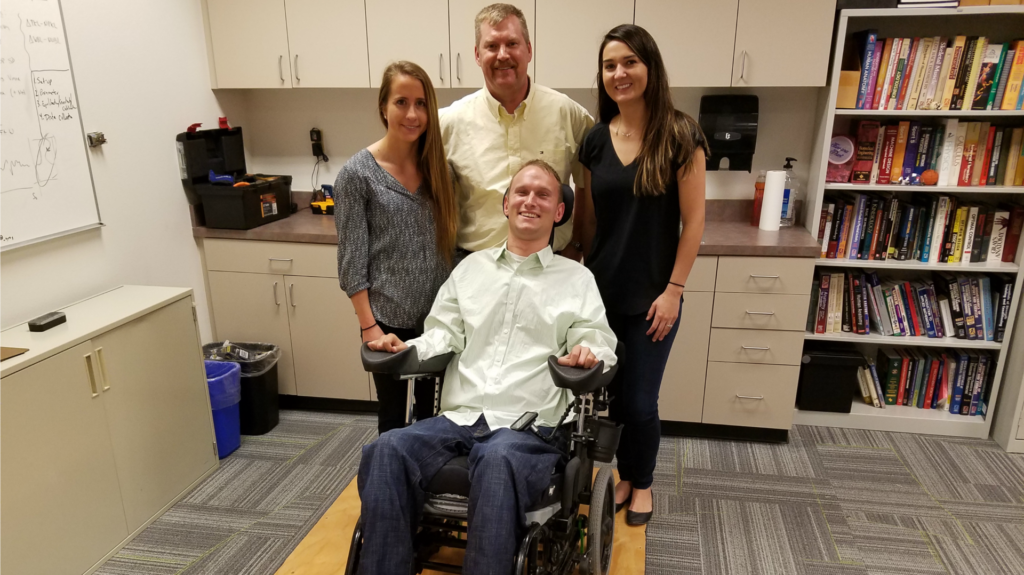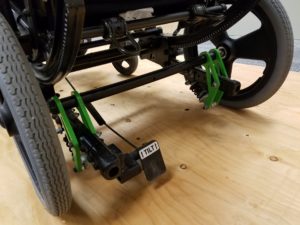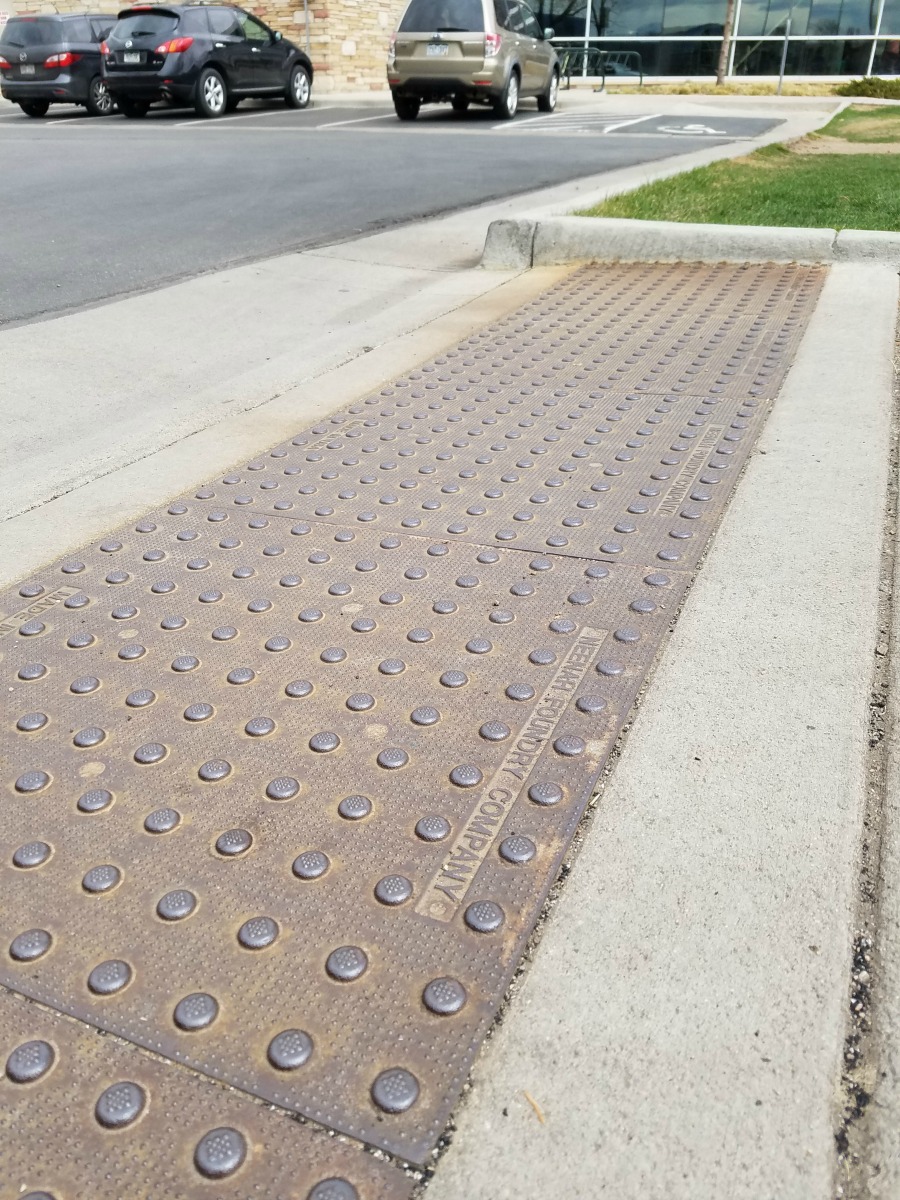
A Colorado State University business and research collaboration is helping to improve the lives and health of wheelchair users. QuadshoX founder and CSU alumnus John Morris has teamed up with Associate Professor Raoul Reiser, director of the Clinical Biomechanics Laboratory in the CSU Department of Health and Exercise Science, to evaluate the effectiveness of the company’s wheelchair suspension system.
QuadShoX: Born@CSU business
Since graduation in 2015, Morris, who was an economics major in the College of Liberal Arts, has dedicated himself to building the business he launched through CSU’s Venture Accelerator program. QuadshoX produces a suspension system for manual wheelchairs, greatly reducing the jolts felt by wheelchair occupants. Morris, who is a wheelchair user himself, realized the potential to improve manual wheelchairs when he switched to a power chair with a full suspension system.

“I was being pushed around CSU in the beginning and wanted more independence with a power chair. I got the idea for the business because my manual chair didn’t have suspension,” said Morris. “We have suspension systems for bikes and cars, why not manual wheelchairs?”
Not only does a suspension system make for a smoother ride, but it also cuts down on adverse health effects felt by wheelchair users. Driving over bumps and sidewalk cracks results in vibrations which can cause pain, skin breakdown, seizures, and spinal misalignment. The addition of suspension can greatly increase comfort and allow wheelchair users to extend the amount of time they can spend in their chairs.
Improving quality of life
“Being able to leave your house is huge for people with disabilities – it greatly improves quality of life if you can spend more hours mobile in your chair – for example 10 or 15 hours vs. five hours,” said Arianna Kilmer, director of finance and administration for QuadshoX and a CSU alumna of the Department of Human Development and Family Studies.
A power wheelchair with suspension can weigh 500 pounds, causing some drawbacks. Having a power wheelchair doesn’t eliminate the need for a manual one. “Everyone needs two pairs of shoes to meet different needs – you have a pair of running shoes and a pair of dress shoes. It’s similar with power and manual wheelchairs. When we want to go to a friend’s house with stairs, or travel on an airplane, we need a manual chair,” said Kilmer.
“The airlines kept breaking my power chair,” added Morris.
While going through the process for FDA approval of their medical device, Morris and Kilmer realized the need for independent testing and data analysis.
“We knew from personal experience and testimonials from our customers that the addition of QuadshoX made a difference in quality of life, but we needed to validate the product. We were going through the FDA and Medicaid reimbursement approval process and we needed a white paper showing that the product really works,” said Morris.
CSU research studies
That’s where Raoul Reiser and his Clinical Biomechanics Lab helped out. Morris was seeing Jason Bradshaw at Certified Rehab Services, who suggested Reiser for testing QuadshoX. Reiser had worked on a project a few years ago with Bradshaw evaluating the pressure relief characteristics of their Skywalker foot-ankle orthotic.
Reiser’s training is in exercise science and mechanical engineering. In addition to being a faculty member in the Department of Health and Exercise Science, he has an appointment in CSU’s School of Biomedical Engineering – he earned his Ph.D. in mechanical engineering at CSU in 2000. Reiser’s research is usually focused on fall prevention in older adults, but he was excited to take on the QuadshoX research project.
Last summer, Reiser completed a small pilot study of four wheelchairs using an accelerometer to measure how much impact various obstacles caused. The study showed that when the chairs were outfitted with QuadshoX, the movement of the wheelchair was significantly reduced when navigating a door threshold, cracked asphalt, pea gravel, and truncated domes (a type of tactile paving found in crosswalks to assist people who have visual impairments).


“With a sensor mounted on the chair, we measured acceleration, which is change in velocity. We are measuring how quickly these bumps are changing movement. We found that the QuadshoX works,” said Reiser.
Now, a bioengineering graduate student working in Reiser’s lab, Molly Hischke, has designed an additional study to evaluate the effectiveness of QuadshoX. The new study, part of Hischke’s master’s thesis, has been expanded to 10 participants, and the variables in the study have been changed to use the same chair and healthy subjects – eliminating some of the factors influencing the outcome such as different wheelchairs and seat cushions absorbing the impact.
Need for QuadshoX
“The U.S. Census estimated in 2010 that there are 3.6 million wheelchair users, illustrating the need for wheelchairs for people with mobility impairments,” said Hischke, who got interested in the project because she previously worked with someone who used a wheelchair.
The type of wheelchair for which QuadshoX is designed is the tilt-in-space wheelchair, which has a tilt-back feature to take pressure off of the user’s bottom – users of the chair often have muscular dystrophy, cerebral palsy, or a spinal cord injury. These primary health conditions often spur a host of secondary health conditions such as muscle spasms, fatigue, and back, pelvic and neck pain.
John Morris and bioengineering student Molly Hischke demonstrate how she tested QuadshoX on simulated surfaces in Raoul Reiser’s Clinical Biomechanics Laboratory for her research study.
“Research has been dedicated to finding the causes of these conditions,” said Hischke. “Research initially focused mostly on people in occupations such as driving tractors or buses. These vehicles can cause health problems due to shock and vibration exposure. Researchers were able to determine a health caution zone, and that shock and vibration exposure decreased with the use of suspension. This initial research also spurred research into wheelchair users and shock and vibration exposure, which determined wheelchair users also have exposure outside of the health caution zone. QuadshoX is definitely meeting a need.”
Hischke will spend the rest of the semester analyzing the data from the study and will write it up for her thesis. She plans to start work on her Ph.D. in ergonomics at CSU this fall.
Advocating for people with disabilities
Morris and Kilmer are continuing to promote QuadshoX – some doors are opening for them as they have received FDA approval for their medical device and also approval for Medicaid reimbursement, so that health professionals can prescribe their product.
“It’s an emotional roller-coaster, with ups and downs, just like any start-up company,” said Morris. “We just returned from the International Seating Symposium in Nashville, which opened up a new world for us. We were able to connect with amazing PTs and OTs and other companies helping people with mobility issues. We were accepted to be a supplier for one of the largest medical supply companies.”
Morris, who is also a member of the City of Fort Collins Commission on Disability, sees his role as an advocate. “I’m so rare because many people who use wheelchairs are non-verbal. I want to be a voice for people with disabilities and help improve their experience.”
QuadshoX was the winner of the largest prize in the 2014 Venture Accelerator Program in CSU’s Institute for Entrepreneurship in the College of Business and also competed in the 2015 Blue Ocean Enterprises Challenge Collegiate Competition. QuadshoX was the recipient of the 2016 Consumer Product IQ Award from Biz West.
The Department of Health and Exercise Science is in CSU’s College of Health and Human Sciences.